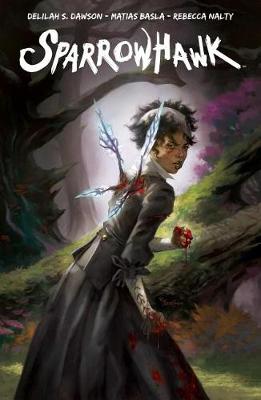Reviewed by Quirky Cat on
Sparrowhawk is a miniseries and the first time that Delilah S. Dawson has written a graphic novel (to my knowledge). As a huge fan of hers, I just knew that I had to read it. And let me tell you, I was not disappointed! Set in Victorian England, this series combines the magic of fairy with elegant storytelling and compelling character arcs.
Artemisia hasn’t exactly had what you’d call a great life; she’s the illegitimate daughter of a Naval Captain, and while his family took her in, they didn’t exactly treat her too well. In fact, her stepmother would love nothing more than to find a good husband to trade her off to.
But that’s the least of Artemisia’s problems, once she’s targeted by a dark and powerful Faerie Queen. Now Art is stuck in the realm of Faerie, with the Queen is out and about gallivanting in a body that looks just like hers.
Sparrowhawk was a brilliant and disturbing read, one that showed the darker side of the cute little faeries people love to talk about so much. This was a dark world, one that was twisted and warped. And Delilah S. Dawson did an excellent job of weaving the web of this tale.
I personally love it when a faerie story is appropriately dark and disturbing. There is so much potential with these dark creatures, and Dawson really ran with it here. Art’s journey was a perilous one, putting her in danger in more ways than one.
It was a compelling story, one that was meant to teach a lesson as much as anything. The twists are shocking and horrifying at times, but all in ways that perfectly fit in with the world that we’ve been introduced to.
I especially love that Dawson established rules for the fae to follow, and then she stuck with those rules. They even became relevant to the plot arc at several vital moments, proving how efficiently these elements were woven into the story itself.
Honestly, I was actually quite sad when this series ended. Not because I was upset with the ending (it was perfection) but because I wanted to keep reading. I actually would love it if this became a longer running series, though that probably won’t happen.
Now let’s talk about the artwork in Sparrowhawk. It was, quite simply, beautiful. It was the ideal blend of gothic/Victorian style with dark and magical faeries. And I’ve got to give all the credit to Matias Basla for making this work so vibrant and alive. And terrifying, don’t forget terrifying.
Honestly, the highlight for the artwork had to be the character designs. Art herself went through several visual transitions through the course of this story, and Basla did an excellent job portraying each and every alteration. I don’t think it would have carried the same weight, had there not been such a strong visual element supporting it.
I honestly and truly loved everything that Sparrowhawk had to offer. If I could read it all again for the first time, I’d do it in a heartbeat. Unless that required me to make a bargain with a faerie – that sounds too risky for me.
For more reviews check out Quirky Cat's Fat Stacks
Reading updates
- Started reading
- 7 December, 2019: Finished reading
- 7 December, 2019: Reviewed
